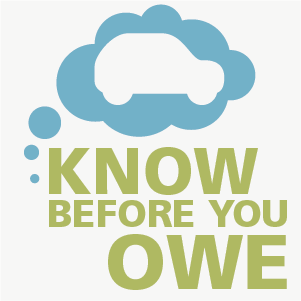STORY HIGHLIGHTS
-
Knowledge is power
-
How to shop for your auto loan
-
Obtaining the best financing
-
What to negotiate for best deal
-
How not to dread paperwork
Know before you owe.
That’s the overall advice of the U.S. Consumer Financial Protection Bureau (CFPB).
And while it sounds simple enough, a lot of thought should go into financing a car, truck or SUV if you don’t want to overpay – or overextend yourself financially.
Over the last five weeks, we shared with you some of the CFPB’s advice on financing a vehicle.
Areas we covered and reprise here are:
- How to shop for your auto loan, not just your car
- Exploring loan choices because hundreds, even thousands of dollars are at stake
- Knowing what’s negotiable – and it’s not just the price of the vehicle or the interest rate
- Understanding how to close the deal before you drive away
 “Take control of your auto loan,” says the CFPB on its comprehensive website. “Whether you’re a first-time borrower or a pro, getting an auto loan can be complicated. Learn how to prepare so you can save money, reduce stress, and get the auto loan that’s right for you.”
“Take control of your auto loan,” says the CFPB on its comprehensive website. “Whether you’re a first-time borrower or a pro, getting an auto loan can be complicated. Learn how to prepare so you can save money, reduce stress, and get the auto loan that’s right for you.”
Financing a car is the second-largest financial obligation for many Americans (after a home mortgage), so it makes sense to take the time to understand the process and get the right deal.
To help you along, the CFPB offers a 16-step auto loan shopping worksheet, Comparing auto loans, which also highlights seven factors that you can negotiate.
Those seven factors are (1) the price of the vehicle, (2) additional features, services or add-ons, (3) expenses such as delivery charges and origination, document and preparation fees, (4) down payment, (5) trade-in value, (6) interest rate, and (7) length of loan in months.
The CFPB also recommends taking the printable worksheet with you to the dealership to “show you are serious about getting the best loan” if you plan to finance the vehicle there.
Whether you follow that advice is up to you, of course, but determining your upfront costs, calculating how much you will need to borrow, knowing how much money you’ll pay over the life of your loan, and finding the total cost of your purchase should be a part of your process.
Then you can be more confident that your vehicle purchase will fit into your budget and that the monthly payments won’t cause financial problems in the future.
The vehicle you want may not be the one you can afford, so it pays to know before you owe.

How to shop for your auto loan
First things first.
When you’re getting ready to purchase your next vehicle, plan to shop ahead for your auto loan.
How much can I afford? How much can I pay as a down payment? Do I want or need a cosigner? How much is my trade-in worth? These are all questions you should be asking yourself before shopping for the vehicle, according to the CFPB.
“Planning ahead to shop for your loan can save money, time, and stress,” says the CFPB. “Making decisions early gives you time to think about your alternatives, and helps you make the right choices.”
To get started, you’ll need to create a budget, the CFPB says.
“You have a better chance of ending up with a loan you can afford and are able to pay on time. A budget also helps you think about ongoing costs such as vehicle maintenance and insurance. You want to be sure that there is room in your budget for both the loan and the other costs of ownership.”
If you’re going to run into financial challenges with the purchase, now is the time to figure that out.
Budgeting before you shop for the vehicle also gives you a chance “to think about ways you can reduce the cost of your auto loan,” according to the CFPB website. That may include saving for a larger down payment, buying a less expensive vehicle, getting fewer add-ons, features or options, deciding if you want or need a cosigner and/or working to improve your credit score.
And if you plan to trade in your current vehicle, you will need to figure out how much it’s worth. Then “you can decide whether to trade it in or sell it yourself,” says the CFPB.
“If you trade it in at a dealership, you and the dealer will decide on the value that will be credited towards the purchase price of your next vehicle. If you sell it yourself, you can use the money you get as a down payment. … Make sure during any negotiations that you consider whether you are getting fair value for your trade-in and whether you are able to fully pay off the old auto loan.”
“Take control of your auto loan,” says the consumer protection bureau on its website. “Learn how to prepare so you can save money, reduce stress, and get the auto loan that’s right for you.”
In other words, know before you owe.
 Obtaining the best financing
Obtaining the best financing
Shop around.
And get preapproved.
Those are among the keys to finding the best financing for your next vehicle, according to the CFPB.
“As soon as you know your budget, shop around … Comparing offers will help you get the loan that’s right for you,” says the CFPB on its website.
Some types of lenders cited by the CFPB are banks, credit unions and nonbank auto finance companies, but dealerships also may offer financing through their lender relationships. (Santander Consumer USA, for example, works with dealerships nationally to provide auto financing.)
Buy-here-pay-here dealerships may offer financing, but interest rates can be higher, says the CFPB.
“Even if you have poor or no credit, it may be worth seeing if there is a bank, credit union, other lender or another dealer that is willing to make a loan to you,” the CFPB suggests.
“Shopping ahead of time will get you ready for negotiating your auto loan and make the process less stressful. Getting preapproved by multiple lenders can mean that they may compete for your business. This puts you in a stronger negotiating position … [and] can help you lower your total cost.”
The preapproval will provide a loan quote with an interest rate, loan length and maximum loan amount based on factors such as your creditworthiness, terms of the loan and type of vehicle, says the CFPB. This allows you to compare different lenders’ offers, which also may be negotiable.
To help you along, the CFPB offers a 16-step auto loan shopping worksheet, Comparing auto loans, which also highlights seven factors that you can negotiate.
“Lenders and dealers are not required to offer the best interest rates available,” says the CFPB. “You may be able to save a lot of money over the life of the loan by negotiating the interest rate.”
“In addition to giving you more options and power in negotiations, a preapproval helps you stay within your budget,” says the CFPB. “Preapprovals allow you to compare interest rates without the time pressure you may feel once you are at the dealership. Then, at the dealership you can focus more attention on items like your trade-in or auto choice.”
But won’t shopping around for the best vehicle financing affect your credit score(s)? Not much, according to the consumer protection bureau.
“Shopping for the best deal on an auto loan will generally have little to no impact on your credit score,” the CFPB says, unless you apply for multiple loans over a long period of time. “[And] the benefit of shopping will far outweigh any impact on your credit.”
“While some consumers are able to pay for their new vehicle, most buyers use financing,” says the CFPB on its website. “Understanding your choices and the loan process will help you save money.”
It’s another good reason to know before you owe.

What to negotiate for best deal
Knowledge is power.
And it might be worth money when you negotiate the purchase of your next vehicle.
Which means that knowing what to negotiate could be your surest road to a satisfying outcome on your vehicle purchase and financing.
With the average cost of a new vehicle around $33,000 and the average cost of a used model now more than $19,000, “negotiating can save you hundreds or even thousands of dollars over the life of your loan,” according to the CFPB.
In addition to the vehicle’s price, options and certain fees, other key factors the CFPB says to take into account when you’re negotiating are:
- Interest rate – Getting a lower rate and APR (annual percentage rate) means “you will pay less to borrow money. The total cost of your loan will be lower.”
- Loan term – Stretching your loan over fewer months “will reduce your total loan cost. A longer loan can reduce your monthly payment, but you pay more interest over the life of the loan.”
- Down payment – Paying more up front – or getting a higher price for your trade in – “will reduce the total amount financed because you will have to borrow less money.”
- Optional products – Extended warranties, GAP insurance and credit insurance are added into your loan and “will increase your total cost because you will be borrowing more money.”
“The total cost of vehicle financing matters,” says the CFPB. “By negotiating for better terms on your loan, you can reduce the total amount of money you pay over time.”
“While the lower monthly payment for a longer period of time may look like the way to go, consider the total interest cost over the life of the loan,” says the federal agency, using an example of a $20,000 loan at 4.75 percent interest. “If you paid off a $20,000 loan in three years, you will pay $1,498 in interest. For a six-year loan, you will pay $3,024 in interest – more than twice as much.”
The CFPB also advises that you “keep track of multiple factors while negotiating.”
To help you along, the agency offers a 16-step auto loan shopping worksheet, Comparing auto loans, which also highlights factors that you can negotiate.
Meanwhile, be sure you know before you owe.

How not to dread paperwork
Paperwork.
It’s almost certainly the part of car shopping that people dread most.
But it has to be done correctly to ensure nothing goes wrong after you’ve driven away your new vehicle.
“If there are things you don’t understand, ask questions,” says the federal Consumer Financial Protection Bureau (CFPB). “You’re signing a contract, and this is a major purchase. It is important that you understand what you are signing.”
To begin with, the federal Truth in Lending Act (TILA), which is intended to help consumers make “apples-to-apples” comparisons between loans, requires lenders to make specific disclosures in writing about important terms before you are legally obligated under the loan.
Those disclosures, according to the CFPB, include:
- The annual percentage interest rate (APR), which is the cost of credit expressed as a yearly rate.
- Finance charges, including the total amount of interest and certain fees you will pay over the life of the loan if you make every payment when it’s due.
- The amount financed, which normally is the amount you are borrowing.
- Total of payments, or the sum of all payments – principal and finance charges – that you will have made at the end of the loan.
- Other important terms such as the number of payments, the monthly payment, late fees, whether the loan has a fixed or variable rate, and whether you can prepay without penalty.
Then, before you drive away, the CFPB says, make sure that you have a copy of all documents, that you and the dealer have signed, and that all blanks are filled in.
In some cases, you shouldn’t drive away at all, suggests the consumer protection bureau.
“Some dealers will allow the customer to take possession of the new vehicle before the loan is approved by the lender. This practice, called ‘spot delivery,’ could put [at risk] the deal that you thought you had. Make sure the financing is nailed down before you sign the contract and drive away with the vehicle.”
“If you don’t have the financing nailed down, the dealer may ask you to come back in and agree to a higher interest rate, add a co-signer, or make some other change different from what you thought was agreed … If this happens and you don’t want to agree to a second deal, you will have to return the vehicle and the dealer will have to unwind the deal and give you back your trade-in and down payment.”
In any case, the CFPB advises, “Walk away if you are not comfortable with any aspects of the loan or the process. You can always leave without completing the deal, take time to think it over and come back. No one can make you accept financing or a vehicle that you are not satisfied with.”
Be sure you know before you owe.




